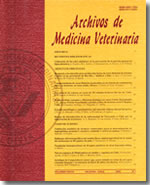Stocking densities used to transport cattle to slaughter in Chile
Main Article Content
Abstract
The stocking densities employed in the transport of 413 loads of cattle were surveyed, comprising a total of 12,931 animals, sent to slaughter at two plants in Chile, one in the Xth Region and the other in the Metropolitan Region, in 2002. For journeys to the plant in the Xth Region, the recorded stocking densities ranged from 106 to 693 kg/m2 (mean 457 ± 6,6 kg/m2). In the Metropolitan Region they ranged from 268 to 632 kg/m2 (mean 453 ± 9,7 kg/m2). In both regions there was a tendency for the stocking densities on the larger vehicles to be higher; the majority of loads were carried in the largest type of vehicle (simple large vehicle and large vehicle with trailer). There was no indication that stocking densities in longer journeys were different from those in shorter journeys in the loads sent to the slaughter plant in the Metropolitan Region. However, there was some suggestion that for cattle transported to the plant in the Xth Region, and which travelled the longest, the stocking densities used were slightly higher. Overall, 32.4 % of the 413 loads surveyed, comprising 35.6 % of the cattle transported, were carried at estimated stocking densities higher than that permitted by the current legislation (500 kg/m2). It is likely that cattle transported at very high densities, and particularly above 500 kg/m2, will suffer more stress and produce poorer quality carcasses with greater amounts of bruising. In Chile, carcasses with bruises that affect muscle tissue are downgraded and the bruised tissue must be trimmed and this reduces their economic value. There might, therefore, be benefits for both animal welfare and meat quality from a more stringent adherence to maximum permitted stocking densities to transport cattle.

